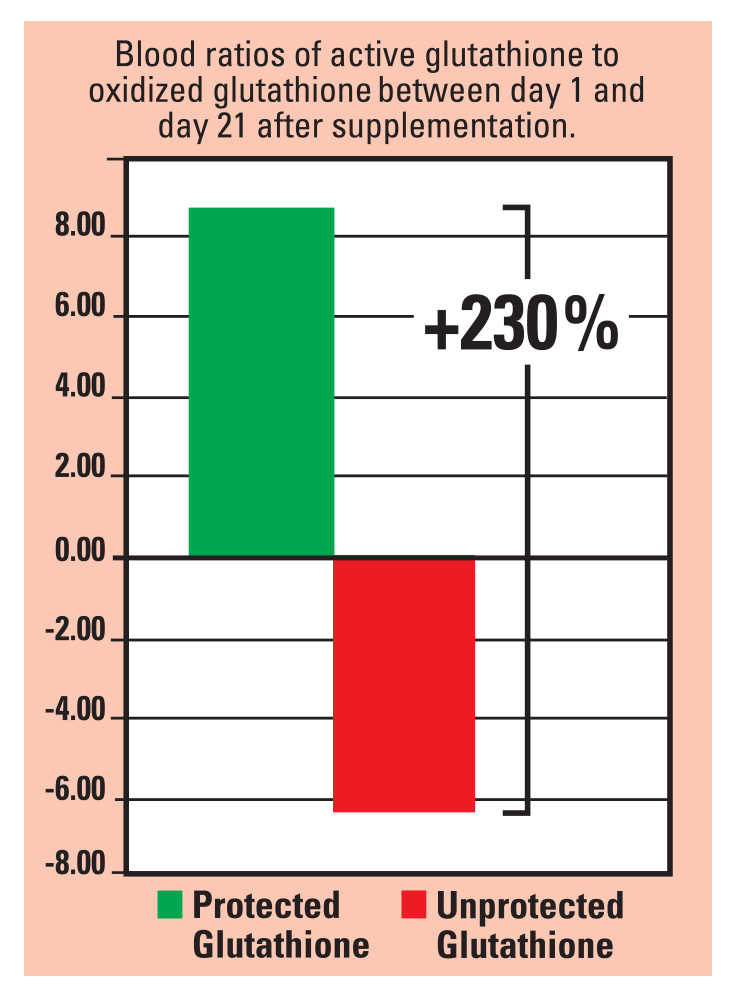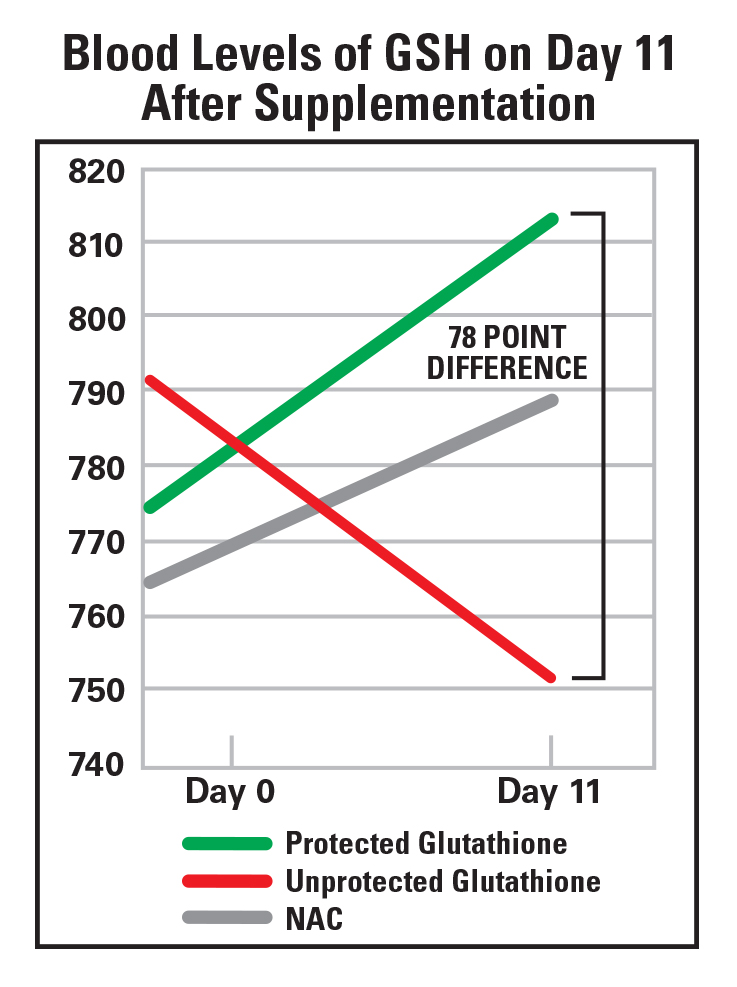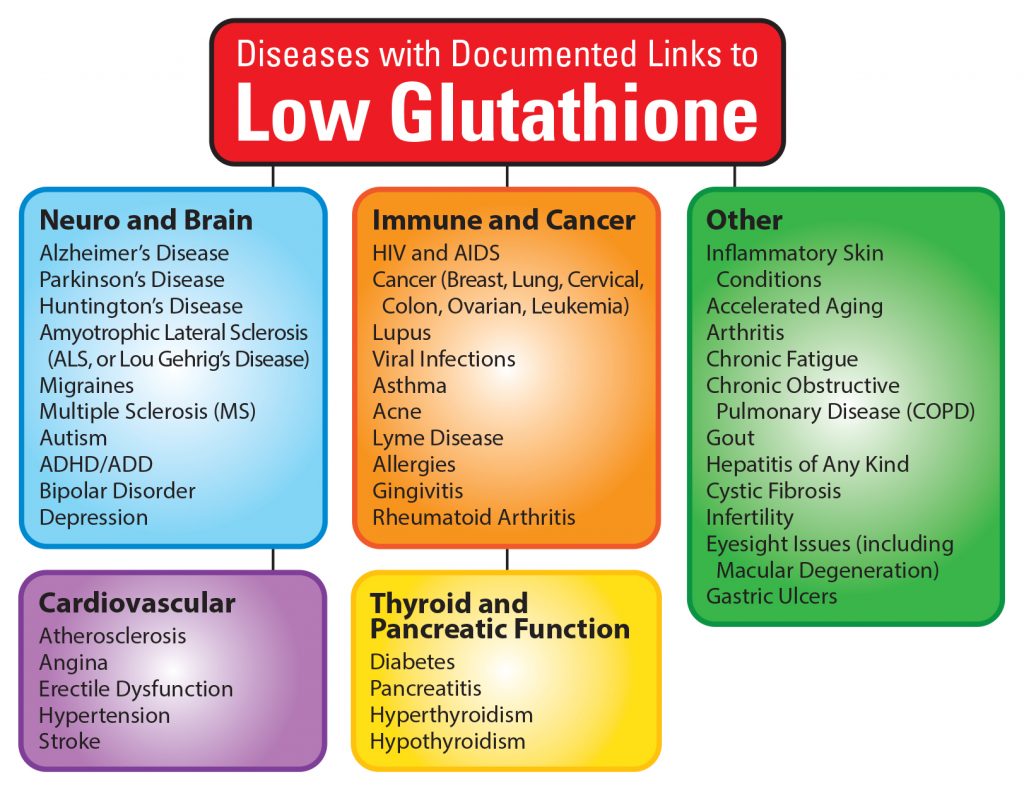HOW GLUTATHIONE CAN SAVE YOUR PATIENT’S LIFE
What do Alzheimer’s disease, Parkinson’s disease, Lyme disease, hypertension, stroke, arthritis, and chronic fatigue and so many other conditions all have in common? They are all diseases with documented links to low glutathione, our most crucial antioxidant.
INFOMEDICA’S BOTTOM LINE:
There is no other compound quite like glutathione. It is so important that your patient’s body makes its own supply to protect it from tumors, keep DNA-damaging oxidative stress at bay, help the body rid itself of toxins, and keep every cell rejuvenated and healthy. Unfortunately, glutathione levels tend to drop due to aging, genetics, disease, environment, and dozens of other factors out of our control. Trying to boost glutathione levels with standard supplements or N-acetylcysteine just doesn’t work. But a revolutionary form of this crucial compound developed in France is powerful and effective.
Taken daily, Glutathione will:
- Prevent brain and nerve damage
- Stop tumor progression and cancer growth
- Rid your patients of health-threatening toxins
- Protect from DNA-damaging oxidative stress
- Reduce the risk and slow the progression of Parkinson’s, Alzheimer’s, and other conditions
- Promote longevity by protecting telomeres
- Boost levels of active, protective glutathione
- Improve the ratio of active versus oxidized glutathione
The Most Crucial of All Antioxidants, For the First Time in a Form the Body Can Actually Use
What if you were told that Ponce de Leon was off base looking for the Fountain of Youth in Florida, because that fountain is in your patient’s own healthy liver? That may be a bit of a stretch, but cells, especially in the liver, make a master antioxidant and detox accelerator that controls critical aspects of aging and preventing disease. That compound is called glutathione. Virtually every person with disease-related frailty is depleted in glutathione. High glutathione levels are associated with longevity—in fact; healthy people over 100 years of age have significantly higher levels of glutathione than the general population. There are over 90,000 studies published on different aspects of glutathione, on everything from Parkinson’s disease, to cardiovascular damage, cancer treatment and prevention, autoimmune diseases, even autism and related disorders.
Unfortunately, in the presence of disease, environmental exposures and genetics, the body’s ability to make this critical compound diminishes greatly. With certain genetic inefficiencies, glutathione production can be reduced 50% or more, and it is estimated that nearly 1 in 3 people has this genetic variant! Age reduces glutathione production, too. By age 40, the majority of people are making 30% less, and by 65, as much as 50% less – and that is in healthy individuals. Anyone with liver stress or disease is going to be making significantly less.
Since glutathione is so powerful, and the lack of adequate levels is associated with too many diseases to count, why don’t we all just load up on glutathione every day?
The answer is simple. Glutathione loses its super powers with digestion. It becomes oxidized, and then it adds to the body’s oxidative stress burden. It is not a matter of enteric coating, or stomach acid – it is the digestive process itself that transforms glutathione into its unfavorable form. That’s why elite integrative medical clinics give this life-saving compound intravenously (directly into the bloodstream), sometimes at a cost of thousands of dollars to their patients.
Research scientists in France have developed a way to keep glutathione stable and deliver it intact by combining glutathione with protective antioxidants. This significantly improves the ratio of active glutathione to oxidized glutathione in a way that other approaches can’t.

Fighting Free Radicals and Oxidative Stress
Glutathione has been described as “the mother of all antioxidants” and this is true, but it does much more. It also boosts and prolongs the protective activity of other antioxidants in the body, like vitamin C and E. This is called antioxidant recycling, and it is crucial as we strive to protect the blueprints inside our cells—DNA—from the damaging effects of oxidative stress. This is important because unchecked oxidative stress is associated with so many diseases—including cancers, neurodegenerative diseases such as Parkinson’s and Alzheimer’s, and heart disease—that it can aptly be considered a killer. Oxidative stress is certainly involved in the death of damaged individual cells, and contributes significantly to the progression of life-threatening diseases.
Removing Dangerous Toxins from the Body
As the liver snags toxins out of circulation, it must prepare them for disposal. This process is called phase l and phase II glucuronidation. This process cannot take place without adequate levels of glutathione. More glutathione = enhanced removal of toxins from the body. This can include drug metabolites, heavy metals, pesticides/herbicides, xenoestrogens like BPA, alcohol, and other toxic chemicals. We are swimming in a sea of tens of thousands of chemicals that never existed before 50 years ago. While we cannot always avoid these toxic exposures, it is important to get them out of our bodies as quickly as possible. This reduces our cumulative exposure to substances linked to cancer and many other potentially devastating diseases.
Immune System Power
The foot soldiers of the immune system are white blood cells. There are a wide variety of soldiers to help protect us from multiple threats, such as disease-causing bacteria, viruses, and fungal infections. The body cannot make white blood cells without adequate glutathione. It has also been shown to stimulate natural killer cell activity, which is especially useful in destroying cancer cells.
Also, higher levels of glutathione are known to preserve telomeres, which are the tail ends of genes that dictate how many times the cell can regenerate. This process is intimately connected to longevity.
The Importance of Glutathione Ratios
Glutathione is made in the body from three amino acids: glutamic acid, cysteine, and glycine. Glutathione molecules have their own “life cycle.” As glutathione (GSH) is utilized and oxidized, it becomes oxidized glutathione (GSSG). In a healthy, youthful person, 90% of the body’s glutathione should be in the GSH form. This is also called “reduced glutathione.” Only about 10% of the body’s glutathione should be in the GSSG (oxidized) form. The ratio between these forms of glutathione is crucially important and is a strong indication of health.
When glutathione is ingested in an unprotected form, meaning it becomes oxidized before it is even absorbed, it contributes to the wrong side of the equation! This increases the oxidative burden in the body because of the excessive amounts of oxidized glutathione waiting to be recharged by antioxidants. In this manner, oxidized glutathione actually depletes antioxidants.
Some practitioners use a precursor compound called N-acetylcysteine (NAC). By increasing raw materials, they hope to make it easier for the body to make more glutathione. This can be somewhat useful for healthier people, because it is reliant on the strength of that individual’s ability to make glutathione. Older adults and people with more serious chronic challenges are less fortunate, and some people have adverse effects with high levels of NAC use.
Did you know that a specific form of glutathione has been shown in human studies to boost the healthy ratio of active glutathione in the body 65% better than NAC? And 230% better than unprotected glutathione! That can mean a life-changing impact on health.

As for increasing levels of glutathione (GSH), this form was compared to NAC and unprotected glutathione, and in just 11 days, raised levels by 38 points. Unprotected glutathione decreased levels of the active form by 40 points. That’s a 78 point difference between these groups, which indicates this form of glutathione is more effective at increasing levels of reduced glutathione.

Other delivery systems for glutathione have required 1,000 mg daily for 6 months to show effects. But because of the French process, only 450 mg of glutathione daily boosted levels 38 points after only 11 days of use, making it a powerful form of this nutrient.
Parkinson’s Disease
While glutathione is useful for virtually any disease or health challenge, it is particularly useful for debilitating neurological diseases like Parkinson’s disease (PD). There are studies using intravenous (IV) glutathione that demonstrate its ability to improve Parkinson’s symptoms. People with this chronic progressive neurological disorder have high levels of oxidative stress and premature cellular die off in a part of the brain called the substantia nigra. Another hallmark of PD is the loss of the brain’s ability to make dopamine. While more studies are needed to further determine the ways in which glutathione helps PD, we have some solid medical theories, the premise of which continues to be borne out as research progresses.
We know that glutathione reduces specific free radical activity that interferes with the proper levels of both dopamine and acetylcholine, which is believed to be the neurochemical imbalance underlying Parkinson’s disease (PD).
As early as 1996, a study entitled “Reduced intravenous glutathione in the treatment of early Parkinson’s disease” found that the progression of PD was reduced, and symptoms improved by 42% after only 30 days of treatment. However, the practice of using glutathione for PD was not widespread, because it had to be administered directly into the veins (IV), necessitating clinic visits and medical staff inserting needles for proper administration.
In another 2009 study, Dr. David Perlmutter, a neurologist at The Perlmutter Health Center, oversaw a human pilot study on the use of IV glutathione for PD, the results of which he published in Movement Disorders. The researchers reported significant improvement during one month of glutathione treatment. When the treatments stopped, the symptoms worsened again. Dr. Perlmutter’s group stated that glutathione was safe and well tolerated.
Research on using therapeutic glutathione is incredibly encouraging for this incurable neurological disease. The stumbling block has always been that it has to be given IV, in a clinic licensed for administration of intravenous drugs, in order to be effective. There are not many clinics nationwide offering this service, and it is very expensive. It is truly a medical break-through to be able to provide this glutathione in an oral form that is still absorbed in its most effective form, without the need for needles, clinics, and huge amounts of medical bills.
Cancer
Cancer is a disease of improper cellular replication. Cell DNA is damaged and the cell’s offspring no longer die on schedule. Oddly, when our body makes immortal cells, our own mortality is in danger. This is the origin of cancer. The immune system destroys cancer cells because it detects this abnormality. However, when too many cancer cells are created, and/or our immune system cannot keep up, we end up with cancer. Not all cancer is the same – there are a myriad of causes and it can affect each person in a highly differentiated manner.
One commonality, however, is that glutathione is useful for the prevention of all cancers via a variety of mechanisms. By protecting the DNA even from the harshest free radicals, our blueprints remain undamaged and less likely to become cancerous cells. And by promoting rapid and effective detoxification, glutathione greatly reduces our overall cellular exposure to toxins, many of which are known carcinogens.
Researchers have explored how glutathione may be useful during cancer treatment as well. In a 2008 study in Japan, doctors found that using IV glutathione dramatically reduced nerve damage in patients being treated with certain kinds of chemotherapy that cause neurotoxicity.
Because glutathione is so crucial to detoxification and immune system vigor, many integrative practitioners use glutathione as part of their clinical protocols for a wide variety of cancers.
Lyme Disease
Many health issues are made even more challenging by the burden of free radicals. Consider the tick-borne Lyme disease, caused by the Borrelia burgdorferi bacteria, which sometimes manifests itself in “bullseye” pattern skin lesions, but can later progress to muscle dysfunction, arthritis, facial palsy, and more. The body’s glutathione levels are depleted in an effort to reduce the damage and spread of the disease.
However, antibiotic treatment doesn’t address the need for the body to help heal itself. In fact, Polish researchers found that patients using antibiotics to treat the skin lesion phase of the disease still had heavy free-radical activity. Even though antibiotics in this case are standard medical procedure, the resulting oxidative damage weakens the system.
This is why glutathione, because it replenishes the body’s own levels, has become a standard practice in the integrative treatment of Lyme disease. It is good practice to bolster our glutathione ratio with an oral form anytime we are going to spend extended time outdoors, or if we live in a particularly tick-heavy environment during the spring, summer, and fall months. If you already have Lyme disease, an oral form should help reduce recurring flare-ups.
Rheumatoid Arthritis
Serbian researchers examined the relationship between oxidative stress, free-radical activity, and rheumatoid arthritis (RA). Even though patients with RA showed higher plasma levels of superoxide dismutase (another of the body’s “super antioxidants”), they also had high levels of pro-oxidants, and increased nitric oxide, an inflammatory marker. Other research with RA patients in Italy showed a strong correlation between inflammation, oxidative stress, and lowered glutathione levels in the bloodstream. In fact, a clinical study in Jordan found that patients with RA showed a 50% depletion of reduced glutathione compared to healthy controls. The researchers concluded that “defense mechanisms against reactive oxygen species are impaired in RA.”
Since rheumatoid arthritis is an autoimmune disease—meaning the body is working against itself—many of the treatment options can seem limited to pain reduction, rather than helping the body get its immune balance back in shape. However, many current studies examining the relationship between RA, oxidative stress, and inflammation seem to share the conclusion that getting those factors under control is critical to stopping the arterial stiffness and damage of the disease.
Autism and Autism Spectrum Disorders
The incidence of autism and related disorders has skyrocketed in our modern, industrialized, toxin-laden world. Doctors have known for quite a while that people with autism are especially challenged when it comes to their ability to handle toxic exposures. Their detoxification systems are rarely robust, and much of this has been traced to an insufficient amount of glutathione activity.
A group of researchers performed a meta-analysis of studies on aspects of autism as it relates to glutathione. They looked at the results of 39 published studies, and determined there is significant evidence that two specific pathways for detoxification are impaired in autism, and that large trials are needed for children with autism to determine if boosting the function of these two pathways will likewise improve autistic behaviors. Both these pathways respond to improved ratios of active glutathione.
Alzheimer’s Disease
Virtually all neurological diseases have some level of oxidative damage as a root cause or major contributor to dysfunction. Therefore, it is not surprising that Alzheimer’s disease (AD) and mild cognitive impairment (MCI) have been the focus of much glutathione research.
A recent study entitled “Elevation of glutathione as a therapeutic strategy in Alzheimer’s disease” concludes: “Increasing glutathione remains a promising therapeutic strategy to slow or prevent MCI and Alzheimer’s disease.” Considering that glutathione levels continue to decline as we age, and that both AD and MCI increase with age, supplementation with effective glutathione can play an important role in prevention, or slowing the progression of this disease.
Human Immunodeficiency Virus (HIV)
One hallmark of HIV is the inability of the immune system to function properly. People with HIV often develop infections that can become life-threatening, and one such infection is tuberculosis. Researchers extracted immune system cells from people with HIV to see how well these cells would control the mycobacterium that causes tuberculosis. They found that the infection itself caused a depletion in glutathione, and that the immune cells, in turn, could not control the mycobacteria. By boosting the body’s levels of active glutathione, the cells could once again control the mycobacteria. The researchers theorized that glutathione depletion may play at least a partial causative role in reduced immune response in people with HIV, and that increasing systemic glutathione could improve immune system function in this group.

Special Glutathione Challenges
Medications can also deplete your patient’s body of glutathione. One is acetaminophen. Acetaminophen is the number one cause of acute liver failure in the U.S. and the only treatment for a dangerous acetaminophen overdose is life-saving glutathione injected into the bloodstream. Certain anti-seizure drugs deplete glutathione, and there is evidence that birth control pills and antidepressant medication can also cause depletion. Therefore, it is especially important to supplement with effective glutathione if your patient must be on one or more of these drugs.
You Can’t Live Without Glutathione
Glutathione is absolutely necessary for health and vigor. In fact, if a person goes 24 hours without food, the liver will steal amino acids from the protein in muscles to make this critical compound. A person will live a longer, healthier, more youthful life with optimal levels of glutathione.
Recommend 150 mg of the reduced, active form of L-glutathione twice daily. If additional support is needed, increase to 300 mg twice daily.


